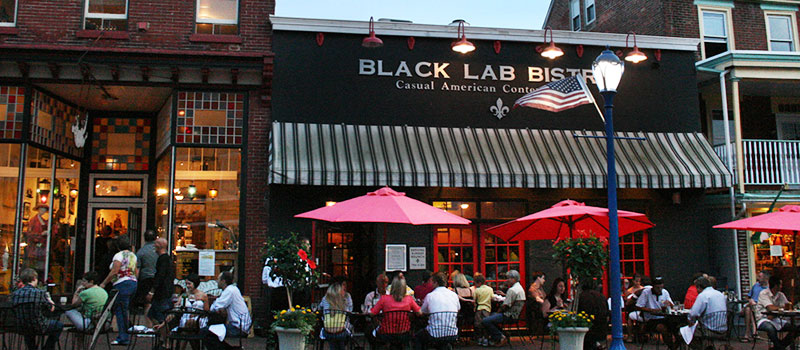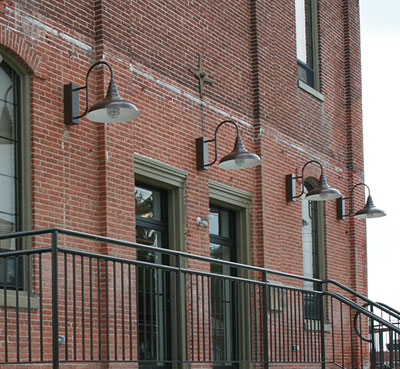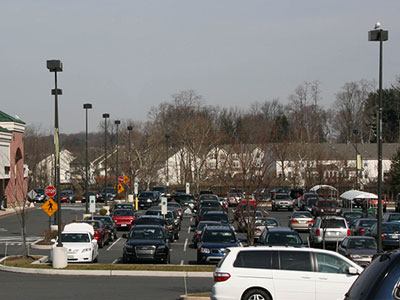Appropriate light fixtures can serve as an attractive architectural feature while improving safety and visibility.
How it Works
A municipality can encourage the proper amount of artificial lighting through the enactment and enforcement of an outdoor lighting ordinance. Lighting regulations can be located either in the zoning ordinance, the subdivision and land development ordinance, or in a separate lighting ordinance adopted according to the applicable municipal code.
Benefits
Glare Reduction
Limiting lighting that trespasses beyond lot boundaries can reduce roadway hazards.
Improves Safety
Better lighting can create more uniformly-lighted areas, improve color rendition, and reduce accidents.
Reduces Effects on Neighbors
Properly shielded and aimed lighting fixtures place light where it belongs and keep it from disturbing neighbors and pedestrians.
Protects Starviews and Wildlife
Limiting "skyglow" at night can improve the views of stars and reduces impacts on nocturnal wildlife.
Energy Efficiency
Providing appropriate intensities and updating types of lighting (e.g. replacing incandescent with LED lights), can save energy.
Encourages More Outside Activity during Nighttime
Better lighting can encourage more people to be outside at night through increased safety and visibility. Nighttime bicycling can also be encouraged and made safer with proper lighting.

The lighting in Phoenixville Borough is compatible with the historic character of the borough.
Lighting is an important safety feature in parking lots.
Recreational or sports field lighting should be turned off after a designated time if located near a residential area.
Get Started
When developing a lighting ordinance, the following components should be addressed in the zoning ordinance, the subdivision and land development ordinance, or in a separate lighting ordinance:
Purpose Statement
This section establishes the need for, and the anticipated results of the ordinance. At a minimum, the ordinance should strive to encourage the amount of lighting that will provide adequate and safe levels of illumination, while respecting the privacy and security of neighboring areas, and also providing for effective enforcement procedures.
Application Section
This section establishes when and where the ordinance will apply, and in which circumstances such as when an application for land development is submitted, or when specified building permit applications are filed.
Definitions
The technical terms that are used in the ordinance are sometimes technical in nature, and should be defined in the ordinance. (These terms typically include foot-candle, full cutoff, glare, illuminance, light trespass, lumen, nit, shielding.)
Plan Submission Requirements
This section includes the details to be shown on plans and compliance procedures to ensure that the ordinance is effective.
Design and Placement Regulations
- Proper illumination Levels. Illumination levels should be balanced for the specific needs; for example, parking lots may need different levels of illumination than convenience stores. (See the resource links and example ordinances for specific guidance on appropriate illumination levels.)
- Lighting fixture design. Designs should be compatible with the local architecture.
- Control of glare. Lamps should be fitted with cut-off fixtures, and be downward-facing to limit unnecessary glare.
- Installation and maintenance. Broken or non-functional fixtures should be repaired as soon as possible.
- Residential development fixture placement. Residential areas need special attention to ensure that lighting is not directed into windows or cause unwelcome shadows.
- Special recreational use regulations. Limits on how late sports field lighting can remain turned on should be considered, particularly when adjacent to residential uses.
- Height of lighting structures. Structures should not be excessively tall or cause unnecessary visual intrusion.
Light fixtures mounted on the canopy at this gas station are recessed and directed downward, reducing glare and protecting the night sky.
Considerations
Preference for Over-Lighting
Some business owners prefer over-lighting to emphasize their sites. Ordinances should be designed to provide the proper level of lighting based on the use and location.
Vague Ordinance Language
Lighting science includes many terms that are not in common usage. The use of vague language or excessively-technical terms should be limited and clearly defined. Ordinance language should be objective and lighting regulations measurable and enforceable.
Enforcement Provisions should be Practical and Efficient
Measurements of lighting intensities can be difficult and special equipment may be necessary. The municipality should have the means necessary to address instances of excessive or inadequate lighting and glare.
Objectivity is Necessary
Criteria for safety or security lighting and lighting needed for other critical tasks should meet the recommended practices of a national body, such as the Illuminating Engineering Society.
Local Orientation is Necessary
Ordinances must be tailored to the needs of the particular municipality, whether it is agricultural, rural, suburban, or urban.

Examples
West Whiteland Township's Subdivision and Land Development Ordinance (Section 281-48) includes comprehensive lighting control provisions.
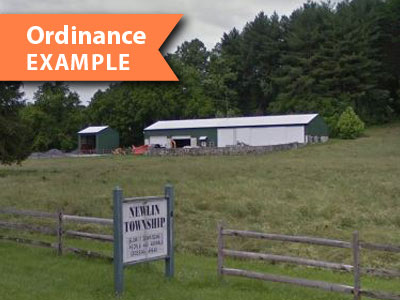
Newlin Township, which is a rural municipality, includes a general limitation on lighting intensity in Section 520 of its Zoning Ordinance. A more-extensive lighting regulation is included in Section 925 of its Subdivision and Land Development Ordinance.
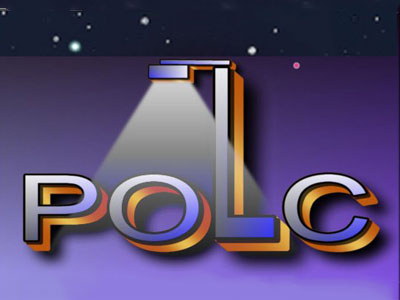
The Pennsylvania Outdoor Lighting Council offers model lighting ordinances that can be incorporated into zoning ordinances, subdivision and land development ordinances and stand-alone ordinances. (Note that this website references several Chester County municipalities with lighting requirements in their zoning and/or in their subdivision and land development ordinances.)


